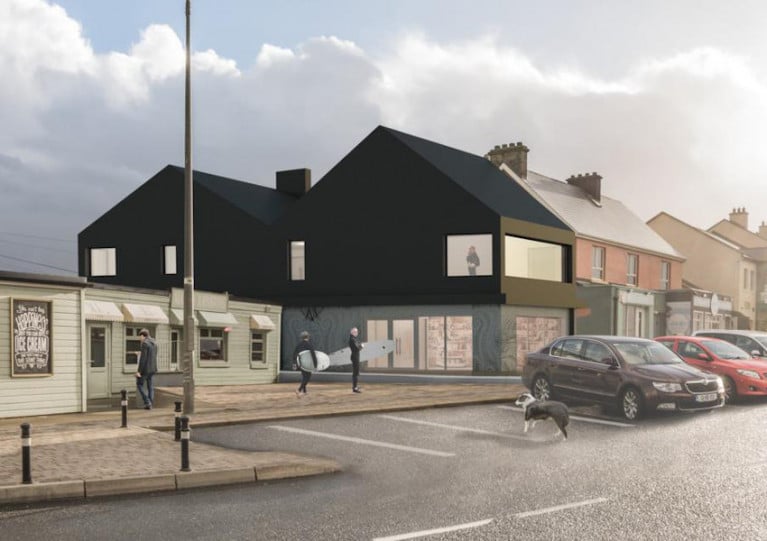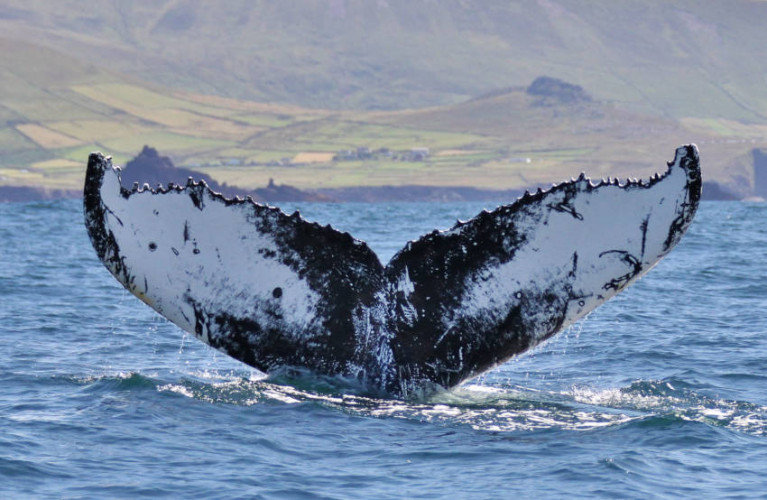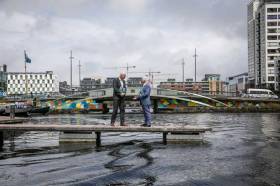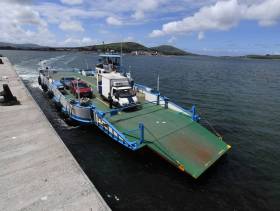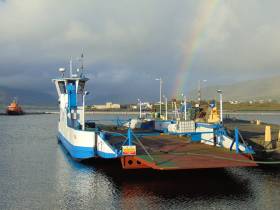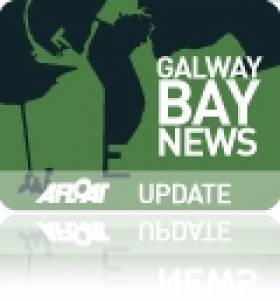Displaying items by tag: Fáilte Ireland
Tourism Boost to Ireland as Brittany Ferries' New Season Commences With Roscoff Route Resuming
Brittany Ferries marks the start of the tourism season with the first sailing of Armorique to the Port of Cork today.
The 30,000 ton, 1500 passenger cruise-ferry had sailed from Roscoff, Brittany and arrived at Ringaskiddy at 09:30 this morning with 330 holidaymakers on board.
The return sailing to the Breton port departed at 1600 on the Ireland-France route which Afloat adds is Brittany Ferries only 'seasonal' operated service.
Armorique will make the call into Cork every Wednesday between now and November, and will be joined on the Cork/Roscoff route from 1st April by Brittany Ferries’ 42,000-ton 2,400-passenger flagship Pont-Aven which will visit Ringaskiddy each Saturday from 11:00-16:00.
Anticipating a busy season ahead, Brittany Ferries bookings already exceed this time last year, with a 34% increase on all routes from Ireland to France and Spain.
In addition, Brittany Ferries has seen a 29% increase in the number of passengers travelling between France and Ireland versus this same period last year, almost half of which are French natives visiting Ireland.
Hugh Bruton, General Manager of Ireland with Brittany Ferries stated, “We are delighted to once again mark the start of a new season. The growing passenger booking numbers show us that 2023 is going to be a boom year for travel both into and out of Ireland. Despite inflation and the current economic climate, passengers want to travel and escape this year and will make things work to do so. Ferry travel offers so many benefits – including avoiding lengthy airport queues and the option to have your car to explore your destination with ease. We are so pleased to see numbers returning close to pre-pandemic levels at last.”
Brian O’Flynn, Fáilte Ireland stated, “A welcome sight each Spring is the Brittany Ferries’ ships sailing in and out of the harbours of Cork and Rosslare. Brittany Ferries carry thousands of tourists to Ireland each season, offering a boost to local economies, tourism and trade. It is so positive to see an increase of 40% in French passengers visiting Ireland this season and we look forward to welcoming them.”
Now offering a twice-weekly service connecting Cork with Roscoff in western France, as well as direct routes from Rosslare to Le Havre, Cherbourg in France and Bilbao in Spain, Brittany Ferries offers a variety of destinations and unparalleled comfort on its fleet of modern ships.
The newest vessel of the fleet, Salamanca, which launched late last year on the Rosslare to Bilbao and Cherbourg routes, is a state-of-the-art cruise-ferry and is the first LNG-powered passenger ferry to regularly operate from Ireland.
Roscoff to Cork sailings run twice weekly, on the Armorique and the flagship vessel Pont-Aven, from March to October 2023.
Strandhill Surfing Centre Gets More Funding from Fáilte Ireland
Additional funding for a long-proposed National Surf Centre of Excellence in Strandhill has been welcomed, as the Sligo Champion reports.
Fáilte Ireland has approved an additional grant of €321,468 for the project in a move hailed as positive news for the town, an important hub for Ireland’s surfing community.
Funding of over €1.6 million was announced for construction of the project in 2018 but councillors heard in October last year that costs had risen due to inflation and pandemic-related issues.
Cllr Declan Bree, chair of the Strandhill Maritime Board, said: “The new centre will be a significant facility for the people of Strandhill and the surf coast on the Wild Atlantic Way and will certainly attract increasing numbers of visitors to the region.”
The Sligo Champion has more on the story HERE.
Whale & Dolphin Watching Could Play Role in Recovery of Irish Tourism Sector Post-Covid, Says Fáilte Ireland Chief
Fáilte Ireland says it plans to capitalise on huge interest in dolphin and whale watching in Ireland in its future tourism marketing plans.
The organisation’s chief executive Paul Kelly made the commitment as he addressed the Oireachtas Committee on Tourism with concerns on the coronavirus pandemic’s affect on tourism.
As RTÉ News reports, Kelly told the committee that revenue across Ireland’s tourism sector has declined by €6 billion, with the loss of hundreds of thousands of jobs.
And he gave a stark warning that any recovery will only be as strong as the support provided to tourism businesses by banks and Government alike.
RTÉ News has much more on the story HERE.
‘Make A Break For It’ On The Shannon This Summer
Waterways Ireland and Fáilte Ireland are encouraging staycationers to ‘make a break for it’ on the Shannon Navigation this summer.
And the latter has compiled a list of all currently open places to eat along with things to see and so along the waterway.
The visitor services directory for the Shannon Navigation is available HERE.
The chief executives of Fáilte Ireland and Waterways Ireland met last week to discuss their new Strategic Partnership Programme to develop tourism along the latter’s network of inland waterways.
The agreement is focused on delivering “a programme of works to improve the quality of the visitor and user experience along Waterways Ireland’s waterways”, the cross-border body said in a statement.
These include the Barrow Navigation, Royal and Grand canals, Shannon-Erne Waterway and Shannon Navigation.
It’s aimed to link these projects with Fáilte Ireland’s regional brands the Wild Atlantic Way, Ireland’s Ancient East, Ireland’s Hidden Heartlands and Dublin.
And the partnership also involved cross-promotion and marketing efforts, such as Waterways Ireland’s Shannon Masterplan to develop sustainable tourism in the Shannon corridor, and future plans to encourage visitors’ engagement with the canals in Dublin city.
“The waterways are a key part of the tourism offering in rural Ireland and the Dublin region,” said Fáilte Ireland chief executive Paul Kelly.
“Unlocking the incredible tourism potential of waterways such as the Shannon River which flows through so many rural communities will mean generating a huge number of opportunities and growth in local economies.”
Waterways Ireland acting CEO John McDonagh added that the Shannon Masterplan in particular “is an excellent first step in our programme and we look forward to a fruitful partnership which benefits the communities and economies across our waterways”.
#Tourism - ‘Ireland’s Hidden Heartlands’ is the new tourism brand for the Midlands region, with a particular emphasis on its inland waterways.
More than 10,000 consumers gave their put to Fáilte Ireland on the development of the brand, which hopes to “bring to life the Midlands' rich natural assets including its many lakes, walkways and blueways”.
The River Shannon will be a central focus, with a Shannon Master Plan currently being developed by Fáilte Ireland in partnership with Waterways Ireland to drive tourism opportunities both on and off the water and in surrounding towns.
A series of food networks and trails will also be developed as part of the new brand.
Launching Ireland’s Hidden Heartlands in Athlone last Friday 13 April, Transport Minister Shane Ross said the brand “will significantly enhance the Midlands as a tourism experience and bring growth and jobs to the whole region.
“We have always been committed to ensuring that Ireland’s success as a world-class tourist destination is shared among the regions. Some of the country’s finest natural assets are in the Midlands, including spectacular lakes, walkways and blueways. Ireland’s Hidden Heartlands will bring these gems to life, offering a unique experience to both domestic and international visitors.”
Ireland’s Hidden Heartlands will cover the ‘heart’ of the country, from Leitrim down to East Clare and extending through Longford, Roscommon, East Galway, as well as parts of Westmeath, Cavan, North Tipperary and Offaly.
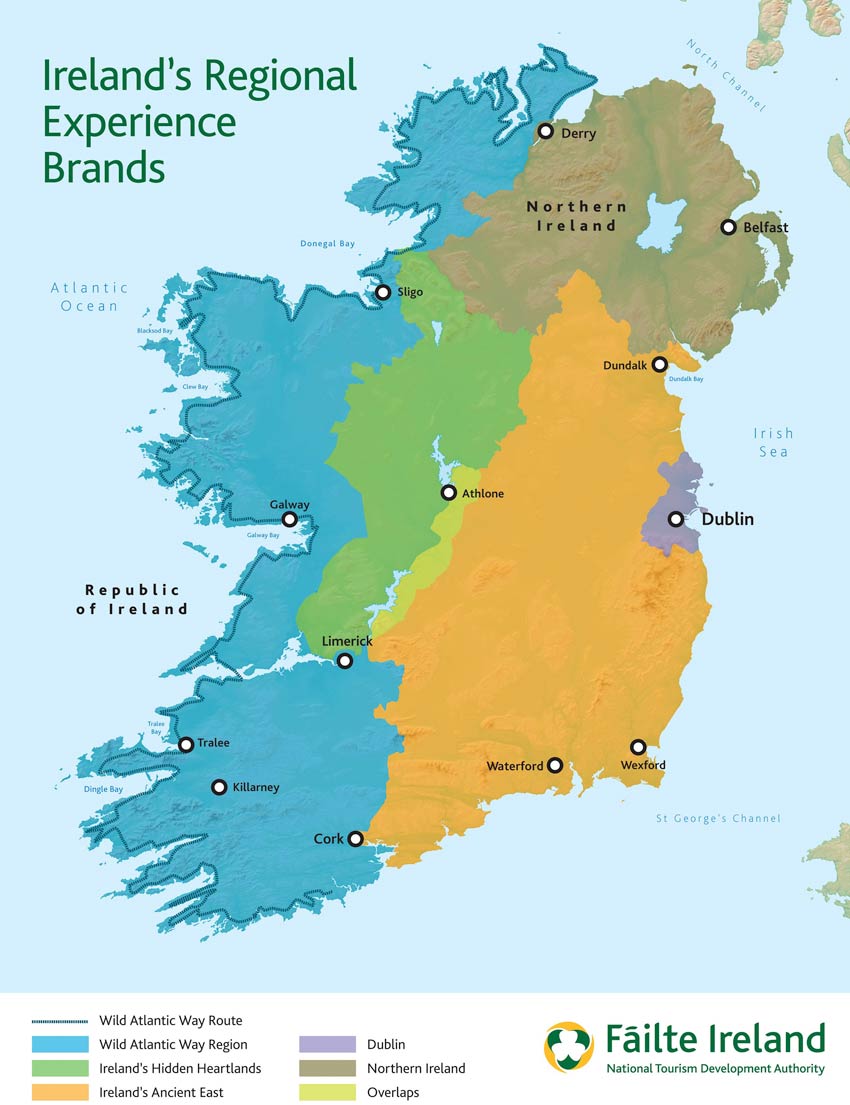
It will complement Fáilte Ireland’s other key brands in the Wild Atlantic Way, Ireland’s Ancient East and Dublin.
“Ireland’s Hidden Heartlands has been developed after months of extensive market testing both here and overseas,” said Paul Kelly, CEO of Fáilte Ireland. “The overwhelming feedback is that visitors from key markets want the opportunity to explore Ireland’s natural gems and rural communities.
“There is also a huge appetite out there for tourists to be active in nature through activities like walking, cycling, angling and boating routes – all of which the Midlands can offer in abundance.”
An initial €2 million has been allocated to start the development stage of the brand, with further funding to follow. This first round of investment will help to develop visitor experiences, support industry development and develop marketing campaigns for the region.
Valentia Island: 'We Need Support to Save Our Ferry'
#islandnews - The Kerryman writes that the ferry service to Valentia Island is a vital asset to all south-west of the county and should be given the financial support it needs to continue into the future.
That was the view of Councillor Norma Moriarty at last week's meeting of the South and West Kerry Municipal District following a deputation by Valentia Island Ferries Limited.
The deputation spokesperson Muiris O'Donoghue explained that, through its own money and borrowings, the group currently has €1million of the €2.8million it needs for a new boat it has designed. While its current boat - a 1963-built craft that has operated every March to October in south Kerry since 1996 - is in good shape according to Mr O'Donoghue, the Marine Survey Office has said that the boat will have to be replaced in 2018.
The group has not secured funding from the Fáilte Ireland Capital Programme for larger project, and says it has done all it can to raise funds through its own initiative. An emergency meeting will take place in the coming weeks between Ministers Heather Humphreys, Michael Ring and Shane Ross to discuss approaches to securing the ferry's future.
Deputy Michael Healy Rae said no date is in place but that Minister Ross "wants it arranged as soon as possible".
For more from the local newspaper, click here.
Valentia Island Ferry Not Eligible Says Fáilte Ireland for Grant Aid
#islandnews- An island ferry says Fáilte Ireland cannot be included, such a new ferry was felt to be crucial for tourism in the South-West, among major projects eligible for grant aid.
As the Irish Examiner writes, EU rules governing state aid for tourism also prohibit aid for the Valentia Island ferry, it says.
The Valentia Island Ferry is of premium importance not just to tourists but serves locals too and is a key piece of infrastructure in the whole of south-west Kerry, a council meeting was told in Kerry this week.
Representatives from the five original families who came together 20 years ago against the odds to form the co-operative to put the ferry in place between the old capital Knightstown and the mainland near Cahersiveen, are campaigning for state funding to allow them replace the ferry with a bigger vessel.
“We are looking for the support of the council not just for Valentia, but for the development of tourism and the economy in the region,” ferry founder, Richard Foran, said in Killorglin.
Valentia is a regular day trip from Killarney now, because of the ferry. The ferry was instrumental in revitalising Knightstown, the old Victorian capital of Valentia.
A bridge which opened in 1971 from Portmagee linked the mainland with the far end of the island but many tourists prefer the ferry.
A new €2.8m ferry has been designed and the co-op will supply €1m, but needs the rest grand-aided, Mr Foran said.
For more on this story click here.
Marinas, Yacht & Boat Berths – Has Failte Ireland Been Lost at Sea In Recent Years?
#marinetourism – Yet another Failte Ireland Marine Research initiative is taking shape to examine the coastal infrastructure for leisure sailors of all kinds, and how facilities might be developed to attract visitors from abroad, while better serving the home fleets. In view of this new research programme, W M Nixon returns to the topic of Dunmore East's potential for development, and sets it in the national context.
Every port in Ireland should be so lucky as to have someone like Harry McLoughlin as Harbour Master. Down in Dunmore East, he's passionate about fulfilling the potential of his picturesque harbour. And it's no easy task, as Dunmore is trying to cope with meeting the demands of a growing home port fishing fleet, while the numbers seeking berths can fluctuate rapidly with visiting boats.
At the same time, the peak summer months will see leisure craft arrive in unpredictable numbers, keen to avail of any sheltered berthing to be had in a port whose strategic usefulness will be obvious to anyone with experience of cruising the Irish coast. And on top of that, from time to time cruise liners will call by, anchoring off and seeking to disembark passengers via their ship's tenders in this characterful little port, where virtually every inch of quayside and pontoon space is already taken by a wide variety of boats.
This provides a colourful and crowded scene, which makes it even more attractive for visitors who might be jaded by the usual big port/cruise liner berthing routine. But it's a headache for a harbour master who has to juggle the often conflicting requirements of different boat interests.
Last week's series of photos gave a snapshot of a few moments in a Dunmore East summer afternoon which well illustrate the challenges that Harry McLoughlin constantly faces. The reality is that the new industrial-style 40 metre pontoon along the East Pier under the lighthouse is a multi-purpose facility. Certainly it has been installed with leisure visitors in mind. But thanks to the welcome growth in the Dunmore East fishing fleet in the last couple of years, there are times when the dedicated pontoons for smaller fishing craft in the southwest corner of the harbour become impossibly crowded. The main quays have to be left clear for large trawlers unloading their catches and their other berthing requirements. So when there's so much pressure on space, some smaller fishing boats are sent across to the Visitors' Pontoon if it happens to be clear, and no visitor is expected.
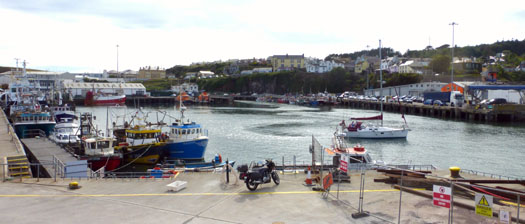
No room at the inn.......an unannounced and unexpected cruising boat finds no space available when pressure is on the berthing at the small craft pontoon. Photo: W M Nixon
It has to be confessed, though, that some of us when cruising are oddly reluctant to call ahead to the Harbour Office when approaching a new port. We prefer just to come in round the pierhead, hoping to be able to choose our own favoured berth without any communication with officialdom at all. It's part of the attraction of cruising when you can do this, as it adds to the sense of freedom which commanding your own small boat is supposed to confer. But the reality is that in a place like Dunmore East, you just have to call ahead, and that is what last week's photos, in the final analysis, seem to be all about.
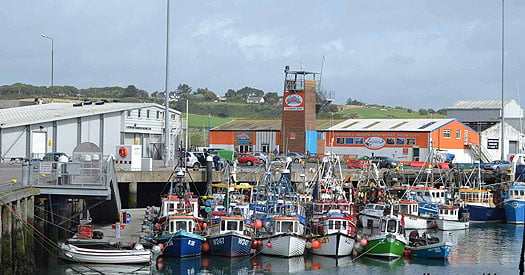
When they pack them in at Dunmore East, they do it big time. A notably trim fleet of smaller craft crowded at their own pontoon. Photo: Aileen Egan
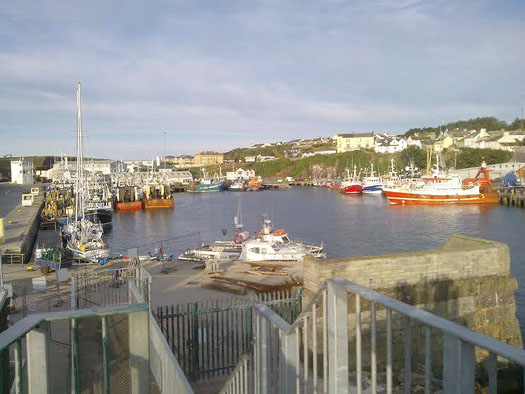
The big boys are in town. Quay space has to be kept available at all times for the comings and goings of larger trawlers. Photo: Harry McLoughlin
But with so much pressure on space, how can Dunmore also cope with the special demands of cruise liner passengers – many of them far from the first flush of youth – disembarking from ship's tenders? Well, in the spirit of community which keeps Dunmore going, the secret is the cruise liner passengers are allowed to come ashore on the usually hallowed territory of the RNLI pontoon.
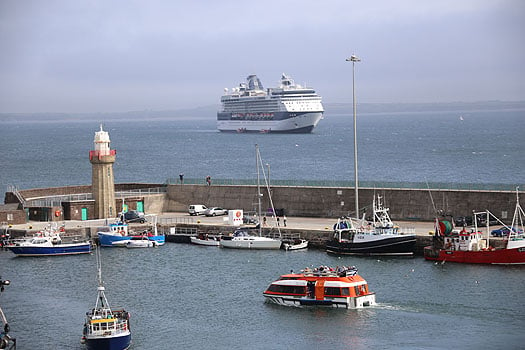
An example of a port harnessing different activities and working together with yachts, trawlers and, in the foreground, cruise line passengers disembarking at Dunmore East. Photo: David O'Brien
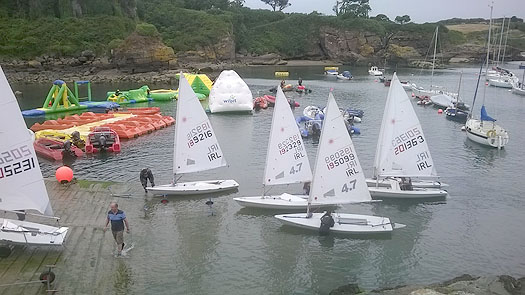
The extended slipway at Dunmore East, which has an abundance of younger sailors who would benefit greatly from an improved harbour. Photo: Harry McLoughlin
That such a temporary re-allocation of resources is necessary from time to time reinforces the genuine demand for improved facilities at many of Ireland's key ports. It will be interesting to see how the priorities are high-lighted by the international research programme which is being implemented under a new Failte Ireland initiative, with an advisory panel of Norman Kean, who researches and edits the Irish Cruising Club Sailing Directions for both the book and on-line versions, Paal Janson the General Manager of Dun Laoghaire Marina, representing the Irish Marine Federation, and Gail MacAllister of the ISA.
We could be forgiven for being a bit bewildered about some of this. Exactly seventeen months ago, in this blog on Saturday April 13th 2013, we were welcoming an up-coming report for Failte Ireland, titled: A Review of Tourism Policy Regarding the Funding of Marina and Berthing Facilities in Ireland. Ultimately known as the Fisher Report and resulting from the work of an agency from outside Ireland, it has since been gathering dust on some shelf. Now, that dust has apparently congealed into aspic with the realisation that the report was so vague and general that it didn't provide any sufficiently clearcut conclusions and proposals to form the basis of a policy.
The questionnaires which are being developed will be targeted at Irish, British, French and German markets. Making a point of ensuring that Irish leisure sailors are included in the equation strikes me as essential, for not only are we often sailing visitors in our own country, as our island's coastlines are long enough and sufficiently varied to make this the case, but visitors from abroad are attracted by the vibrant Irish sailing scene. Thus anything which provides better facilities for our own sailors will be beneficial in a much wider context.
The guidance of someone as experienced in cruising as Norman Kean will be invaluable, as the framing of the questions is vital in producing a worthwhile result. Then too, Norman is at the heart of the Irish sailing and boating scene, both with his key role in the internationally-praised Cruising Club Sailing Directions, and the fact that he is based at Courtmacsherry in West Cork, a friendly port which has shown it knows a thing or two about how to make visiting cruising boats feel welcome, and wish to come back again.
So we can be sure that the doughty Norman will accurately and eloquently represent the views and requirements of the Irish boating community, whose enthusiastic approach to sailing in all its forms is an important part of the package for boating visitors. This is all-too-frequently overlooked by the powers-that-be, who are so keen to tot up numbers of new visitors that they overlook the existence and needs of Ireland's large home sailing community, all of whom are more than willing to be personal hospitality managers when visiting boats come to call.
But in any case, regarding the ultimate value of market research, we should remind ourselves of Henry Ford's opinion on it, as we did back on April 13th 2013. The great car pioneer and manufacturer said that when starting out in business, if he'd asked his potential customers what they wanted, they'd have demanded a faster horse...
It seems that with the Fisher Report, we didn't even get a slow horse, we got a lame duck. So for the moment, instead of setting up a ponderous set of questions, Afloat.ie will simply dream on. What do we want for good cruising in Ireland? Well, setting aside those who insist that a giant astrodome should be installed to cover the entire country before they'll come near the place, we have a wish list that begins with good sailing which is sometimes sufficiently challenging to make the completion of each passage a satisfying experience. And all of it to be done with a background of attractive coastal scenery.
As for making safe passages, and then getting the best from each haven at the end, we'll know that the Irish Cruising Club Sailing Directions are an indispensable guide. Ideally, we'll be in an area with an abundance of natural anchorages where we can put down our own anchor without fear of fouling abandoned moorings or other detritus on the seabed. If there are reliable and regularly-serviced visitors moorings, that's fine and welcome too. But we who cruise the Irish coast, and the western seaboard in particular, do so in the knowledge that any proper cruising vessel will have her own more-than-adequate ground tackle.
If we happen to be sailing along an Irish coastline which lacks an abundance of natural harbours, we would like handy artificial harbours – preferably with marinas – at about 35 mile intervals or even less, as 35 nautical miles seems to be the magic distance which is easily attainable in one day, yet its completion really does make you feel you've moved on.
This sense of needing to move on is part of what cruising is all about. It satisfies some hidden genetic urge which most of the time is dormant in us, but given half a chance, there is indeed a gypsy in our soul. However, having satisfied our wanderlust by the modest total of 35 or so miles made good, what will we expect to find ashore?
Your complete dyed-in-the-wool cruising person is often content simply to stay on board enjoying the natural grace which is provided by a boat lying comfortably to her own anchor. Be sure, though, to choose a spot where your pride-and-joy won't be uncomfortably tide-rode, which so often turns out to be the case in what looked to be a snug if narrow inlet.
In their wellnigh perfect anchorage, these traditional cruising folk will be happy to dine aboard. At such times, you realise that a good sea cook is a pearl beyond price, much more valuable – in this age of sensitive auto-helms – than a top helmsman for the general welfare of the crew and the success of the cruise.
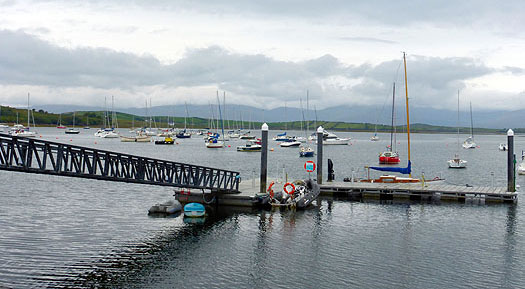
Mayo SC's landing pontoon at Rosmoney on Clew Bay is an impressive piece of work. Photo: W M Nixon
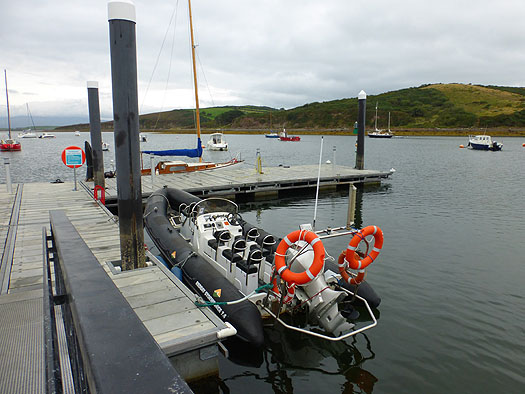
The attractive facilities at Mayo SC bring in a membership from all over North Connacht. Photo: W M Nixon
Such traditional cruising people, if they do go ashore, are quite happy to scramble up some awkward foreshore for a bracing hike on nearby moorland, or even climb a mountain or two. But the vast majority of us – and an increasing majority as newcomers arrive in cruising – prefer to get easily ashore from an anchored boat via the dinghy onto a good jetty, and ideally a landing pontoon - such as you see at civilised places like Mayo Sailing Club on Clew Bay – is both much safer, and more convenient.
However, let's face it, when cruising you're on your holidays. After a perhaps slightly rugged day at sea, there's no doubting the benefits conferred by a comfortable marina berth. Apart from the safety and security, there's the simple sense of freedom. While there are those who enjoy the restricted and aromatic confines of a cruising yacht, for many it can quickly become claustrophobic, and the freedom of personal movement which a marina confers on the cruising crew can be vital for preserving harmony. And it greatly broadening the options of what to do once ashore, because unlike the crew from an anchored boat reliant on one dinghy, crews in marinas can come and go as they please.
Perhaps it's the fact that they have this choice is one of the reasons why, by and large, cruising crews tend to stay as a group when they are ashore – they may even be celebrating the fact that they're still friends, and a marina can help in this.
As to what's needed ashore, basically it's good hospitality facilities within easy walking distance. The "easy walking" requirement cannot be over-emphasised. Once you're into a cruise, you're moving at a different speed in a different frame of mind, and too much walking on tarmac or cobblestones or whatever becomes simply tiresome. In fact, you'll have noticed that some experienced cruising folk are surprisingly willing to take a taxi if there's anything other than a short walk involved. For they also know that, coming off a boat, you're out of sync with road traffic – a cruising crew ambling along a busy road can be a hazard to themselves and a distracting menace for other road users.
So we're beginning to get the picture of our cruising crew's Irish dream port. It has to be colourful, characterful, and compact. Ideally, all facilities for every possible need, including repair, fuelling and re-storing, should be within easy reach from a marina berth with full-sized walkways and proper pontoons – you might be a bit rocky on your pins after a rough day at sea, and sea legs need something better than a cogglesome thin little finger pontoon.
From all this, it is clear that Kinsale is the Irish cruising port par excellence, even if the Yacht Club marina does get over-crowded betimes, and even if, when the ebb is running hard and there's a strong sou'easter blowing, the boats rafted along the outer berths have a bumpy time of it. Despite all this, Kinsale has so much to offer we can learn from it, and from other top cruising visitor places like Dingle and Howth while the new harbour at Greystones on the Wicklow coast is a fascinating example of a port in active transition from a small boat mini-haven to a proper harbour with marina and full facilities for multiple uses.
But equally there has to be fresh thinking about making the best of existing ports. In other words, the old notion that some ports should be exclusively designated as Fisheries Harbours is patently nonsense when those harbours are located in key positions with ready-made characterful port towns and villages as part of the package.
There still is some residual resistance in a few ports to the very notion of a marina being installed. But it should be seen in the broader context as an indicator of attractive peace and prosperity, every bit as much as a facility for visiting boaters who will be keen to spend their holiday money ashore. I was recently in Ballycastle in the far northeast corner of Ireland, and in going up the town we noticed a welcome air of prosperity. Buildings had been painted and generally spruced up. This was even more marked in the area down beside the little harbour, where there's a small but very useful marina, and the regular ferry leaves from its much-improved berth for Rathlin Island six miles away. We still think of it as the "new harbour and marina" at Ballycastle, although it has been around for some time now. But such facilities are put in for the long haul, and it is now that Ballycastle harbour's attractive sense of purpose and prosperity has had this beneficial spinoff for the mood of the town.
 The small but convenient and very useful marina at Ballycastle has played a part in the North Antrim town's improved perception of itself. Photo Kevin Dwyer courtesy Irish Cruising Club
The small but convenient and very useful marina at Ballycastle has played a part in the North Antrim town's improved perception of itself. Photo Kevin Dwyer courtesy Irish Cruising Club
Elsewhere in the north, one of our favourite ports is Ardglass, where one of the most strategically useful marinas on the entire Irish coast was slotted into a spare corner of what had formerly been a decidedly rugged "fishing-and-fishing-only" place, and the mood has been pleasantly lightened as a result.
 A handsome and obviously fast perfomance cruiser in the hoist at an Irish port – but where is it? Photo: W M Nixon
A handsome and obviously fast perfomance cruiser in the hoist at an Irish port – but where is it? Photo: W M Nixon
But for pure rugged essence of total fishing port, you just couldn't beat the Wild West atmosphere of Killybegs in Donegal. The fishing has been mighty, and there are now at least 23 multi-millionaires in the Killybegs area whose wealth has been drawn from the sea. Yet in recent years, the Killybegs attitude has softened slightly. The place has tidied itself up, and as one of the best natural harbor in the entire northwest of Ireland, it has put out some visitors' mooring for leisure craft, while serious cruising men visiting this challenging but rewarding area find that the Mooney Boats quayside yard with its massive travel hoist is a real boon.
Killybegs does have space where a marina could be installed to be handy to the town while not interfering with fishing boat needs, and judging by the quality boats flying foreign ensigns on the visitors moorings, its usefulness as a crew-change port is a particular asset, as the international airport at Knock isn't so very
far away.

Killybegs is the answer, with Mooney Boats a boon for boat visitors to Donegal. Photo: W M Nixon

Once upon a time, Killybegs was fishing, just fishing, and only fishing. But now the deep sea trawlers are well used to sharing their harbour with visiting yachts, in this case a couple of Dutch boats. Photo: W M Nixon
So if Killybegs can take aboard the idea of a marina, maybe the other mega-fishing-port of Castetownbere in southwest Ireland can do so too. That said, there is a hugely popular little marina already well established at the other end of Bere Island at Lawrence Cove, but a convenient facility at the western end of Bere Haven would improve cruising options.

The 78ft cruiser-racer Whisper contrasts vividly with the lifeboat in Castletownbere, a fishing port which might be able to find space for a marina. Photo: W M Nixon
In the cruising heartlands of West Cork, we can expect new movement on the long-proposed marina at Schull, which would greatly help in rationalizing pier use. But in bustling Baltimore there may be more of a challenge in creating a proper marina, as waterfront space beside the village is limited. As it is, the current berthing pontoon which juts straight out into the harbour can be a mixed blessing when there's a serious wind from the west, with the pitching and banging of boats and pontoon sections being a nuisance at best, and a real hazard at its worst.
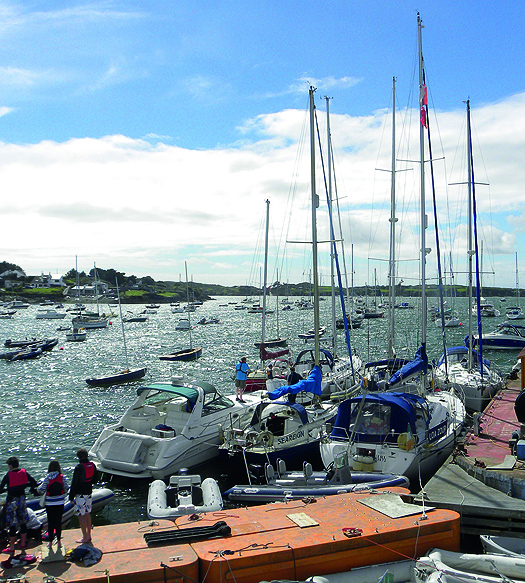
The berthing pontoon at Baltimore can become a decidedly exposed place when the wind is fresh from the west.
But all these places already have something of a range of choices, in Dunmore East there's just this one little bit of a harbour, and everyone wants a piece of it. I make no excuses for dragging out the dog-eared rough sketch of what a marina might look like if there was to be a realistic separation of fishing and leisure use, for while we do suggest that places which were originally exclusively fishing ports can be usefully modified to be partially leisure ports as well, there's no doubting the primary need of clearly defined boundaries between the two within the harbour confines.
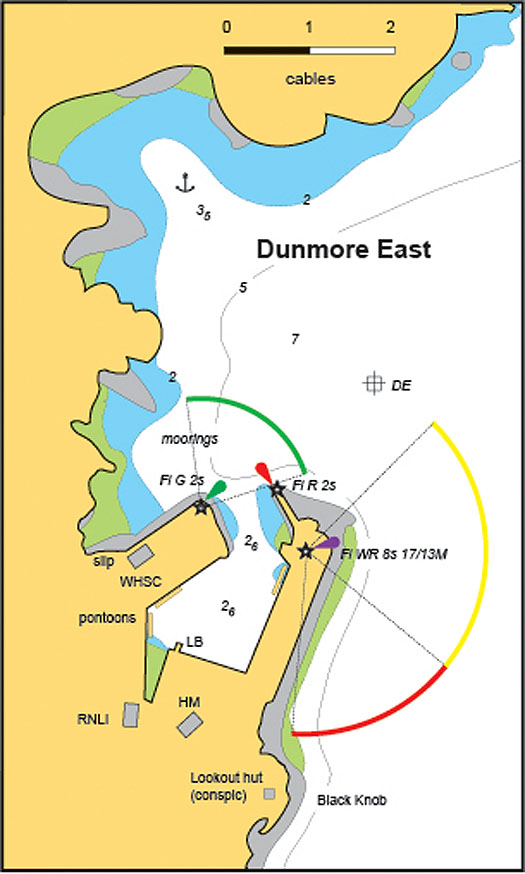
Dunmore East as it is today, and surely ripe for development
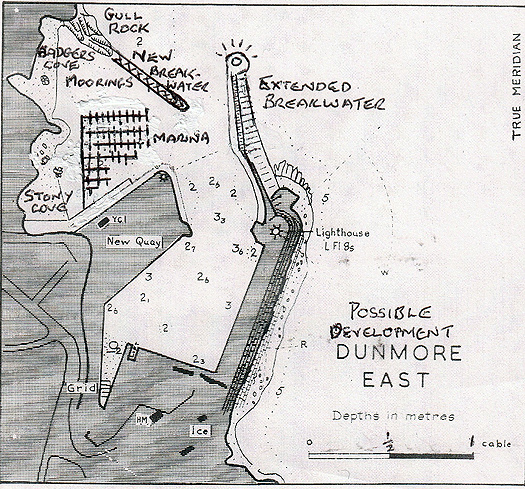 The possibilities for a marina at Dunmore East are suggested in this rough sketch
The possibilities for a marina at Dunmore East are suggested in this rough sketch
For there's no doubt we all wish the very best for Dunmore East. It very much wants to be a hospitable port, and can do it very well too, given half a chance. Harry McLoughlin was talking enthusiastically about some of the fine boats and great sailing people he has welcomed since he took over as Dunmore's Harbour Master in the Spring of 2013, and from 2014 he best remembers the great Jim Mottram.
Jim cruises alone in his pretty little Elizabethan 23 Reservation out of Christchurch in Dorset just outside the west entrance to the Solent, and over the decades he has logged some formidable voyages, down to Spain, and round Britain three times. But as his boat has a lifting keel which reduces the draft to 2ft 6ins, for 2014 he decided that a cruise to Ireland with a spell on the inland waterways would make for a change.
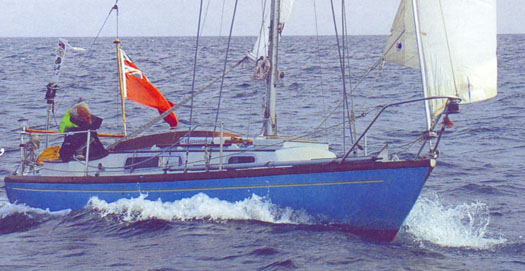
The most senior sailor – Dunmore East visitor Jim Mottram has cruised thousands of miles in his Elizabethan 23 Reservation.
So he arrived into Dunmore East early in the season, intending to go up the Barrow, across Ireland on the Grand Canal, then back to the sea again via the Shannon through Limerick. But after going up to Waterford from Dunmore, he reckoned the early-season surge down the River Barrow would make things unnecessarily difficult, so he cruised right round the south coast of Ireland and went up the Shannon Estuary to Limerick. There, he unstepped his mast, and motored north through Lough Derg and into the Grand Canal at Shannon Harbour, then right across Ireland to swoosh down the Barrow – which becomes even more lovely the further south you go – until in New Ross the manager of the Three Sisters Marina John Diamond set him up again, and on he went down to Dunmore East for a warm welcome and a celebration of his near-circuit of Munster.
Harry McLoughlin discovered Jim had a special birthday coming up while he was in Dunmore East, so he and his wife took the lone skipper along to the Waterford Harbour Sailing Club for a party to celebrate both the birthday and the success of his cruising since he'd last been with them.
And which birthday was Jim Mottram celebrating?
His 80th, of course.
Galway Ironman Triathlon Cancelled Due To Funding Issues
#GalwayBay - Funding issues have resulted in the cancellation of what would have been the third annual Ironman 70.3 triathlon in Galway later this year, as the Galway City Tribune reports.
Organisers have expressed their sorrow at having to call a halt to the event, which already had some 1,600 people registered to take part, due to what they claim is a lack of funding from Fáilte Ireland.
“I think it’s ironic that we have to turn people away when ‘The Gathering’ is on,” said co-organiser Eoin McCormack.
The most recent Galway Ironman 70.3, staged in August 2012, overcame local swimming ban concerns to see more than 2,000 athletes swim 1.9km along the Salthill Promenade before a 90km cycle through Connemara and a 21.1km run through the streets of Salthill and The Claddagh.
It's estimated that the inaugural event in 2011 was worth more than €10 million to the local economy.
The Galway City Tribune has more on the story HERE.



























